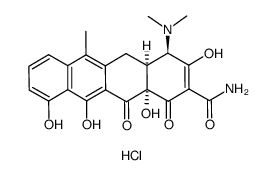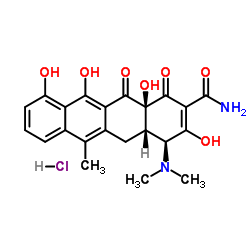4465-65-0
| 中文名 | 4-差向脱水四环素盐酸盐 |
|---|---|
| 英文名 | (4R,4aS,12aR)-4-(dimethylamino)-1,10,11,12a-tetrahydroxy-6-methyl-3,12-dioxo-4a,5-dihydro-4H-tetracene-2-carboxamide,hydrochloride |
| 中文别名 |
4-差向脱水四环素
4-表-脱水四环素盐酸盐 |
| 英文别名 |
4-Epianhydrotetracycline HCl
MFCD00151455 4-Epi-Anhydrotetracycline Hydrochloride 4-Epianhydrotetracycline hydrochloride |
| 描述 | 4-表脱水四环素盐酸盐是抗生素四环素的降解产物。4-表脱水四环素盐酸盐对假单胞菌、农杆菌、莫拉菌、芽孢杆菌和大肠杆菌(MIC50s=0.75-16mg/L)具有活性。 |
|---|---|
| 相关类别 |
| 沸点 | 618.6ºC at 760 mmHg |
|---|---|
| 熔点 | 220ºC |
| 分子式 | C22H23ClN2O7 |
| 分子量 | 462.88000 |
| 闪点 | 327.9ºC |
| 精确质量 | 462.11900 |
| PSA | 161.39000 |
| LogP | 1.95810 |
| 外观性状 | Powder | Orange |
| 储存条件 | 密封储存,储存于阴凉、干燥的库房。避免阳光直射,常用氩气保护。 |
| 稳定性 | 对空气,光照敏感。吸收湿空气和空气中的水分。 避免与不相容材料,空气。湿空气,水接触。 与强氧化剂,强还原剂,强碱反应。 |
| 计算化学 | 1.疏水参数计算参考值(XlogP):无 2.氢键供体数量:6 3.氢键受体数量:8 4.可旋转化学键数量:2 5.互变异构体数量:708 6.拓扑分子极性表面积161 7.重原子数量:32 8.表面电荷:0 9.复杂度:855 10.同位素原子数量:0 11.确定原子立构中心数量:3 12.不确定原子立构中心数量:0 13.确定化学键立构中心数量:0 14.不确定化学键立构中心数量:0 15.共价键单元数量:2 |
| 更多 | 1. 性状:橘黄色粉末 2. 密度(g/mL,20℃):未确定 3. 相对蒸汽密度(g/mL,空气=1):未确定 4. 熔点(ºC):220 5. 沸点(ºC,常压):未确定 6. 沸点(ºC,0.2mmHg):未确定 7. 折射率(n20/D):未确定 8. 闪点(ºC):未确定 9. 比旋光度(º):未确定 10. 自燃点或引燃温度(ºC):未确定 11. 蒸气压(mPa,20ºC):未确定 12. 饱和蒸气压(kPa,25ºC):未确定 13. 燃烧热(KJ/mol):未确定 14. 临界温度(ºC):未确定 15. 临界压力(KPa):未确定 16. 油水(辛醇/水)分配系数的对数值:未确定 17. 爆炸上限(%,V/V):未确定 18. 爆炸下限(%,V/V):未确定 19. 溶解性:溶于水 |
Synonym:None known Section 2 - COMPOSITION, INFORMATION ON INGREDIENTS
Risk Phrases: 63 Section 3 - HAZARDS IDENTIFICATION EMERGENCY OVERVIEW
Possible risk of harm to the unborn child.The toxicological properties of this material have not been fully investigated.Light sensitive.Moisture sensitive.Air sensitive. Potential Health Effects Eye: May cause eye irritation. Skin: May cause skin irritation. Ingestion: May cause irritation of the digestive tract. May cause liver and kidney damage. The toxicological properties of this substance have not been fully investigated. Inhalation: May cause respiratory tract irritation. May cause liver and kidney damage. The toxicological properties of this substance have not been fully investigated. Chronic: May cause liver and kidney damage. May cause reproductive and fetal effects. Section 4 - FIRST AID MEASURES Eyes: Flush eyes with plenty of water for at least 15 minutes, occasionally lifting the upper and lower eyelids. Get medical aid. Skin: Get medical aid. Flush skin with plenty of water for at least 15 minutes while removing contaminated clothing and shoes. Wash clothing before reuse. Ingestion: Never give anything by mouth to an unconscious person. Get medical aid. Do NOT induce vomiting. If conscious and alert, rinse mouth and drink 2-4 cupfuls of milk or water. Wash mouth out with water. Inhalation: Remove from exposure and move to fresh air immediately. If not breathing, give artificial respiration. If breathing is difficult, give oxygen. Get medical aid. Notes to Physician: Section 5 - FIRE FIGHTING MEASURES General Information: As in any fire, wear a self-contained breathing apparatus in pressure-demand, MSHA/NIOSH (approved or equivalent), and full protective gear. During a fire, irritating and highly toxic gases may be generated by thermal decomposition or combustion. Extinguishing Media: Use agent most appropriate to extinguish fire. Do NOT get water inside containers. Use water spray, dry chemical, carbon dioxide, or appropriate foam. Section 6 - ACCIDENTAL RELEASE MEASURES General Information: Use proper personal protective equipment as indicated in Section 8. Spills/Leaks: Vacuum or sweep up material and place into a suitable disposal container. Clean up spills immediately, observing precautions in the Protective Equipment section. Avoid generating dusty conditions. Provide ventilation. Place under an inert atmosphere. Do not get water inside containers. Section 7 - HANDLING and STORAGE Handling: Wash thoroughly after handling. Use with adequate ventilation. Avoid contact with eyes, skin, and clothing. Keep container tightly closed. Avoid ingestion and inhalation. Store protected from light. Handle under an inert atmosphere. Store protected from air. Do not allow contact with water. Store and handle protected from air. Keep from contact with moist air and steam. Storage: Do not store in direct sunlight. Store in a tightly closed container. Keep under a nitrogen blanket. Store in a cool, dry, well-ventilated area away from incompatible substances. Do not expose to air. Store protected from moisture. Store protected from light. Store under an inert atmosphere. Section 8 - EXPOSURE CONTROLS, PERSONAL PROTECTION Engineering Controls: Facilities storing or utilizing this material should be equipped with an eyewash facility and a safety shower. Use adequate ventilation to keep airborne concentrations low. Exposure Limits CAS# 4465-65-0: Personal Protective Equipment Eyes: Wear appropriate protective eyeglasses or chemical safety goggles as described by OSHA's eye and face protection regulations in 29 CFR 1910.133 or European Standard EN166. Skin: Wear appropriate protective gloves to prevent skin exposure. Clothing: Wear appropriate protective clothing to prevent skin exposure. Respirators: A respiratory protection program that meets OSHA's 29 CFR 1910.134 and ANSI Z88.2 requirements or European Standard EN 149 must be followed whenever workplace conditions warrant respirator use. Section 9 - PHYSICAL AND CHEMICAL PROPERTIES Physical State: Powder Color: orange Odor: none reported pH: Not available. Vapor Pressure: Not available. Viscosity: Not available. Boiling Point: Not available. Freezing/Melting Point: 220 deg C Autoignition Temperature: Not applicable. Flash Point: Not applicable. Explosion Limits, lower: Not available. Explosion Limits, upper: Not available. Decomposition Temperature: > 220 deg C Solubility in water: in water: 1:1100 m/v Specific Gravity/Density: Molecular Formula: Molecular Weight: 464.89 Section 10 - STABILITY AND REACTIVITY Chemical Stability: Stable under normal temperatures and pressures. Conditions to Avoid: Incompatible materials, light, moisture, exposure to air, exposure to moist air or water. Incompatibilities with Other Materials: Moisture, air. Hazardous Decomposition Products: Hydrogen chloride, nitrogen oxides, carbon monoxide, irritating and toxic fumes and gases, carbon dioxide. Hazardous Polymerization: Has not been reported. Section 11 - TOXICOLOGICAL INFORMATION RTECS#: CAS# 4465-65-0 unlisted. LD50/LC50: Not available. Carcinogenicity: 4-Epianhydrotetracycline Hydrochloride - Not listed by ACGIH, IARC, or NTP. Section 12 - ECOLOGICAL INFORMATION Section 13 - DISPOSAL CONSIDERATIONS Dispose of in a manner consistent with federal, state, and local regulations. Section 14 - TRANSPORT INFORMATION IATA Not regulated as a hazardous material. IMO Not regulated as a hazardous material. RID/ADR Not regulated as a hazardous material. Section 15 - REGULATORY INFORMATION European/International Regulations European Labeling in Accordance with EC Directives Hazard Symbols: XN Risk Phrases: R 63 Possible risk of harm to the unborn child. Safety Phrases: S 28A After contact with skin, wash immediately with plenty of water. S 36/37 Wear suitable protective clothing and gloves. S 37 Wear suitable gloves. S 45 In case of accident or if you feel unwell, seek medical advice immediately (show the label where possible). WGK (Water Danger/Protection) CAS# 4465-65-0: No information available. Canada None of the chemicals in this product are listed on the DSL/NDSL list. CAS# 4465-65-0 is not listed on Canada's Ingredient Disclosure List. US FEDERAL TSCA CAS# 4465-65-0 is not listed on the TSCA inventory. It is for research and development use only. SECTION 16 - ADDITIONAL INFORMATION N/A |
| 个人防护装备 | Eyeshields;Gloves;type N95 (US);type P1 (EN143) respirator filter |
|---|---|
| 危害码 (欧洲) | Xn |
| 风险声明 (欧洲) | 63-36-22 |
| 安全声明 (欧洲) | 36/37/39-26 |
| 危险品运输编码 | NONH for all modes of transport |
|
~% 
4465-65-0 |
| 文献:McCormick et al. Journal of the American Chemical Society, 1957 , vol. 79, p. 2849,2856 |
| 上游产品 1 | |
|---|---|
| 下游产品 1 | |


